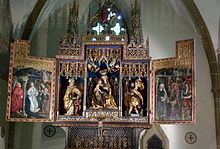Herlin Altar (Bopfingen)
The Herlin Altar is a late Gothic winged altar in the Protestant town church St. Blasius in Bopfingen , a town in the Ostalb district in Baden-Württemberg .
history
The altar was commissioned by the abbess of the Cistercian monastery of the Assumption of Mary in Kirchheim am Ries , who held the right of patronage over the parish church of St. Blasius. The church was probably dedicated to St. Blasius , one of the fourteen helpers in need , was consecrated. The saint's patronage was first mentioned in writing in a letter of indulgence from 1299 . Many sick people who hoped to be cured through a pilgrimage made a pilgrimage to Bopfingen and the Blasius Care facility was set up for them, the income of which also went to the Kirchheim Cistercian Sisters.
In 1465 Count Johann von Helfenstein donated a relic of St. Blasius. To present this relic, a new altar, which was completed in 1472, was to be created in the workshop of the Nördlingen painter Friedrich Herlin (around 1430–1500). Herlin, who was based on the Dutch masters Rogier van der Weyden (1399 / 1400–1464) and Jan van Eyck (around 1390–1441), designed the altar. He entrusted other artists with the carving. The signature can be read on the lower frame of the outer wing: “Dis werck hat made friderich herlein moler zuo nordlingen MCCCCLXXII”.
Left wing of the outside
Usually the wings of the altar were closed and one could see the exterior with scenes from the life of St. Blasius, the patron saint of the church, are depicted. On the left panel, St. Blaise is shown as a bishop who is captured by the Roman governor and his soldiers in Sebaste . On the way to prison, the saint is stopped by a woman whose pig was stolen by a wolf. Through the prayer of St. Blasius lets the wolf off the pig. On the left above the woman's head you can see the wolf with the pig slipping out of its mouth. The late medieval city backdrop in the background is inspired by Rothenburg ob der Tauber , where Friedrich Herlin created the panels for the high altar of the Jakobskirche . The magnificent dresses of the figures correspond to the fashion of the time.
Right wing of the outside
The right panel on the outside depicts the martyrdom of St. Blaise, who is tied to a gallows and tortured with spears by the governor's henchmen. Behind the torture scene you can see St. Blaise trapped behind bars in a tower. A woman brings him the head and feet of a pig on a plate. It is the woman whose pig Blasius saved from the wolf.
Left wing inside
The birth of Christ is shown on the left panel on the inside. The baby Jesus lies naked at the feet of Mary. To the left of Maria stands Joseph with a burning candle in his hand, to the right two midwives have rushed to help, a midwife brings a lantern. The scene takes place in a half-ruined room, of whose former splendor a marble column and stone arcades testify. As on the panels on the outside, a late medieval town with towers and stately buildings can be seen in the background, reminiscent of Rothenburg ob der Tauber. The crumbling city wall is interpreted as an indication of the transience of earthly power. A traveler who is led by an angel approaches on a winding path.
Right wing inside
The panel on the right inside shows the adoration of the Magi , who are dressed in precious robes and present their gifts to the baby Jesus. They embody different ages and different parts of the world. The same city as on the left panel is shown in the background, with the buildings being shown from a slightly different perspective.
Carved figures
The middle section of the altar is made up of three panels with carved figures, which are attributed to a sculptor from the Upper Rhine who succeeded Niclas Gerhaert van Leyden . In the center, Mary sits with the baby Jesus on her lap, to whom she hands a grape, referring to the transformation of wine into the blood of Jesus during the Eucharist . Two angels hold a crown over her head and two angels hold her cloak.
The left figure shows St. Blasius, who pulls a fishbone out of a child's neck and thus keeps it from suffocating. The figure on the right represents St. Christophorus carrying the baby Jesus across a river.
Predella
The predella originally served to store the relics that were visible to the pilgrims behind the iron grille. Today there are carved figures from the 15th century that depict Jesus and the Twelve Apostles .
literature
- Hermann Baumhauer: The Herlin Altar in Bopfingen and its city church , Stuttgart / Aalen 1972. (not evaluated)
- Ralf Krüger: Friedrich Herlin - painter and altar builder . Yearbook of the Alt-Rothenburg Association 2004, Rothenburg ob der Tauber 2004. (not evaluated)
- Michael Rau: Evangelical town church St. Blasius Bopfingen . Kunstverlag Josef Fink, Lindenberg 2006, ISBN 978-3-89870-313-0 .
Web links
- The Herlin Altar Evangelical Church Congregation Bopfingen
Coordinates: 48 ° 51 '26.01 " N , 10 ° 21' 8.34" E




